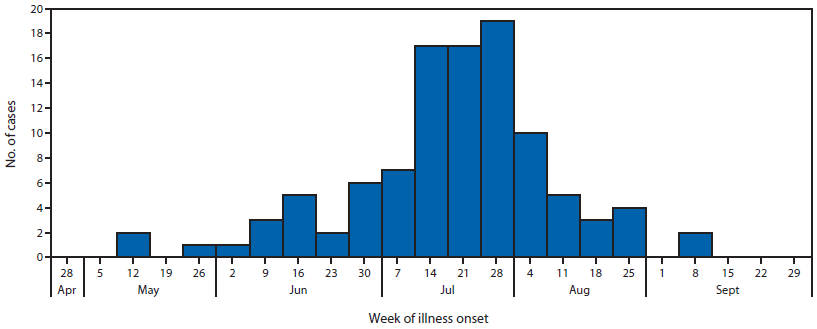* Available at http://www.issc.org/closuresreopenings.aspx.
† Additional information available at http://www.cdc.gov/vibrio/investigations/vibriop-09-13/advice-consumers.html.
Anna E. Newton, MPH1, Nancy Garrett1, Steven G. Stroika1, Jessica L. Halpin, MS1, Maryann Turnsek1, Rajal K. Mody, MD1 (Author affiliations at end of text)
Vibrio parahaemolyticus (Vp) is found naturally in coastal saltwater. In the United States, Vp causes an estimated 35,000 domestically acquired foodborne infections annually (1), of which most are attributable to consumption of raw or undercooked shellfish. Illness typically consists of mild to moderate gastroenteritis, although severe infection can occur. Demographic, clinical, and exposure information (including traceback information on implicated seafood) for all laboratory-confirmed illnesses are reported by state health departments to CDC through the Cholera and Other Vibrio Surveillance system. Vp isolates are distinguished by serotyping (>90 serotypes have been described) and by pulsed-field gel electrophoresis (PFGE).
Vp serotypes O4:K12 and O4:K(unknown) comprise the Pacific Northwest (PNW) strain and, within the United States, had not been associated with shellfish outside the Pacific Northwest before 2012. During May–July 2012, Vp of the PNW strain associated with shellfish from Oyster Bay Harbor in New York caused an outbreak of 28 illnesses in nine states. Simultaneously, Vp of the PNW strain caused an outbreak of illnesses on a cruise ship docked on the Atlantic Coast of Spain; illness was associated with cooked seafood cooled with ice made from untreated local seawater. All Vp isolates from ill persons in the U.S. and Spanish outbreaks that were further subtyped were indistinguishable by PFGE (2).
In 2013, this same indistinguishable strain was traced from shellfish consumed by ill persons to a larger area of the U.S. Atlantic Coast, causing illness in 104 persons from 13 states during May–September (Figure). The median age of patients was 51 years (range = 22–85 years); 62% were male. Six (6%) patients were hospitalized; none died. Multiple outbreaks appeared to be occurring, accounting for many of these illnesses. Illness was associated with consumption of raw shellfish and seafood traceback was reported for 59 (57%) illnesses. Of these illnesses, 51 (86%) involved seafood that could be definitively traced to a single harvest area. The implicated harvest areas were located in Connecticut (20 illnesses), Massachusetts (15), New York (10), Virginia (four), Maine (one), and Washington (one). The remaining eight illnesses with traceback information involved seafood that could not be definitively traced to a single harvest area (locations reported included harvest areas of the Atlantic Coast of the United States and Canada). In response to the illnesses, four Atlantic Coast states closed implicated harvest areas; two issued shellfish recalls (3). The number of foodborne Vp cases in the United States traced to Atlantic Coast shellfish was threefold greater in 2012 and 2013 compared with the annual average number reported during 2007–2011.
This PNW strain is possibly becoming endemic in an expanding area of the Atlantic Ocean. The mechanisms for this introduction are not known. During the 2014 Vibrio season, beginning in the spring, clinicians, health departments, and fisheries departments should be prepared for the possibility of shellfish-associated diarrheal illness caused by this strain again. Appropriate actions, such as quick closure of implicated harvest areas, will help prevent additional illnesses. The Interstate Shellfish Sanitation Conference maintains a list of shellfish harvest area closures and recalls.* Clinicians seeking an etiology of diarrhea in a patient who has recently consumed raw or undercooked shellfish should notify the microbiology laboratory that Vp is suspected; the use of special culture media (thiosulfate citrate bile salts sucrose) facilitates identification of Vibrio species. Consumers can reduce their risk for Vp infection by avoiding eating raw or undercooked shellfish, especially oysters and clams.†
Collaborating state and local health departments and shellfish authorities. Food and Drug Administration.
1Division of Foodborne, Waterborne, and Environmental Diseases, National Center for Emerging Infectious and Zoonotic Disease, CDC (Corresponding author: Anna Newton, ivz9@cdc.gov, 404-639-2839)
* Available at http://www.issc.org/closuresreopenings.aspx.
† Additional information available at http://www.cdc.gov/vibrio/investigations/vibriop-09-13/advice-consumers.html.
FIGURE. Vibrio parahaemolyticus illnesses (N = 104) associated with consumption of shellfish from Atlantic Coast harvest areas, by week of onset — United States, 2013

Alternate Text: The figure above shows Vibrio parahaemolyticus illnesses (N = 104) associated with consumption of shellfish from Atlantic Coast harvest areas, by week of onset, in the United States during 2013. In 2013, this same indistinguishable strain was traced from shellfish consumed by ill persons to a larger area of the U.S. Atlantic Coast, causing illness in 104 persons from 13 states during May–September.
Use of trade names and commercial sources is for identification only and does not imply endorsement by the U.S. Department of
Health and Human Services.
References to non-CDC sites on the Internet are
provided as a service to MMWR readers and do not constitute or imply
endorsement of these organizations or their programs by CDC or the U.S.
Department of Health and Human Services. CDC is not responsible for the content
of pages found at these sites. URL addresses listed in MMWR were current as of
the date of publication.
All MMWR HTML versions of articles are electronic conversions from typeset documents.
This conversion might result in character translation or format errors in the HTML version.
Users are referred to the electronic PDF version (http://www.cdc.gov/mmwr)
and/or the original MMWR paper copy for printable versions of official text, figures, and tables.
An original paper copy of this issue can be obtained from the Superintendent of Documents, U.S.
Government Printing Office (GPO), Washington, DC 20402-9371;
telephone: (202) 512-1800. Contact GPO for current prices.
**Questions or messages regarding errors in formatting should be addressed to
mmwrq@cdc.gov.